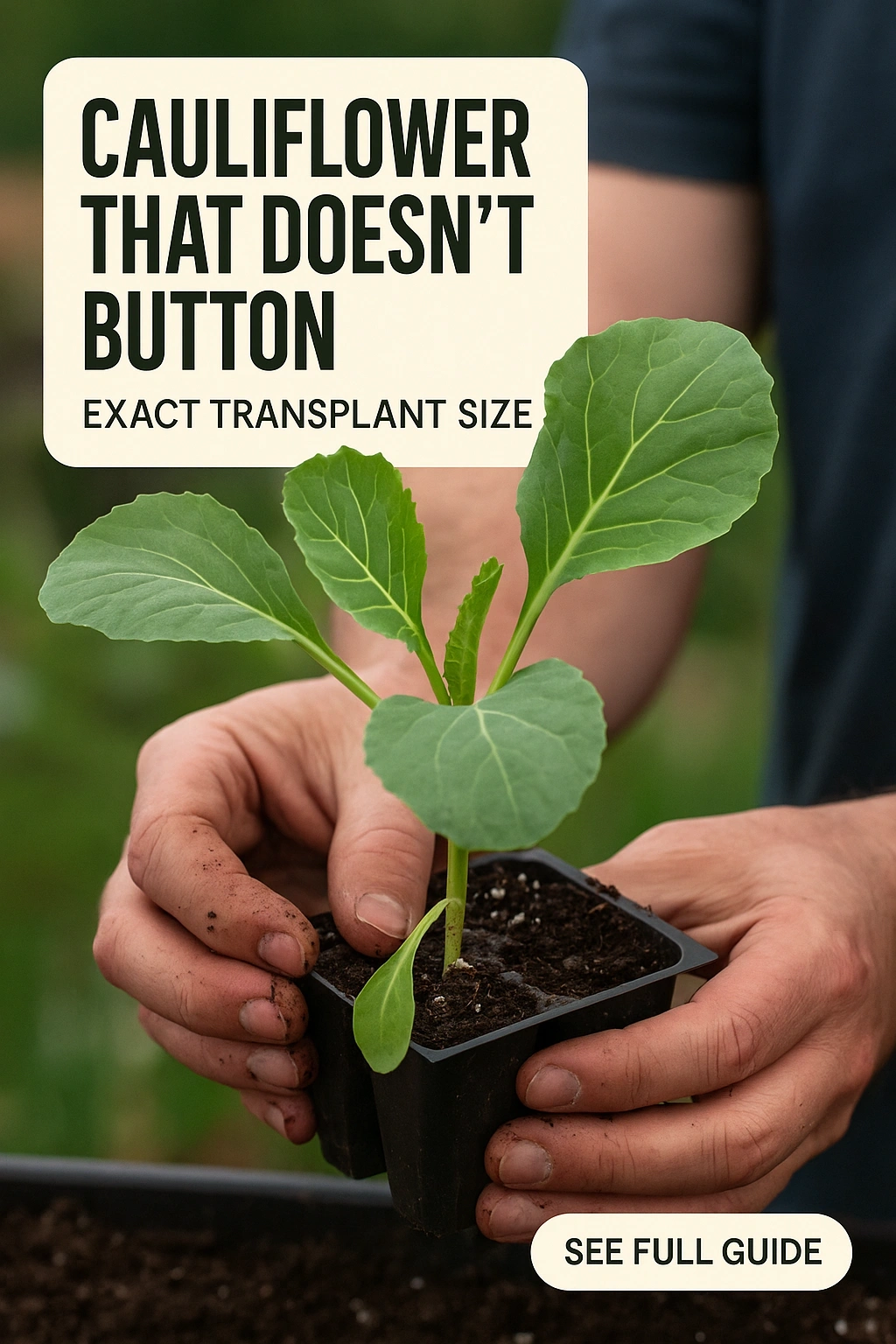
Cauliflower is a nutritious vegetable that has gained popularity among home gardeners and chefs alike. However, one common issue encountered by gardeners is the problem of cauliflower that does not button, which refers to the failure of the plant to form a proper curd or head. This article will delve into the critical factor of transplant size and how it affects the successful growth of cauliflower. Learn the optimal transplant size to ensure robust growth and the formation of beautiful, edible curds.
What Does “Buttoning” Mean in Cauliflower Growth?
Buttoning is a term used to describe the situation when cauliflower plants fail to develop a mature head. Instead, they may produce small, undeveloped curds that are unappetizing and often inedible. Several factors contribute to this phenomenon, including environmental conditions, care practices, and, importantly, the size of the transplant at the time of planting.
Ideal Transplant Size for Healthy Cauliflower
The size of cauliflower transplants plays a pivotal role in their ability to thrive and produce heads. A transplant that is too small may struggle to establish itself in the garden, while one that is too large may experience transplant shock. Finding the right balance is essential for ensuring your cauliflower plants grow to their full potential.
Recommended Size for Transplants
The ideal transplant size for cauliflower is typically between 4 to 6 weeks old, with a height of 4 to 6 inches. At this stage, the plants should have a healthy root system and a few true leaves, which indicate they are ready to be transplanted into the garden. This size allows the plants to acclimate well to their new environment while minimizing stress.
Factors Influencing Cauliflower Transplant Success
Several factors contribute to the successful establishment of cauliflower transplants. Understanding these aspects can help gardeners provide the best conditions for their plants, leading to better yields and quality. Here are some key considerations:
Soil Quality and Preparation
Healthy soil is vital for cauliflower growth. Ensure your soil is well-draining and rich in organic matter. Conduct a soil test to assess nutrient levels and pH. Cauliflower prefers a pH of 6.0 to 7.0. If necessary, amend the soil with compost or fertilizers to create an optimal growing environment.
Timing of Transplanting
The timing of transplanting cauliflower is crucial. Aim to transplant seedlings when the soil temperature is consistently between 60°F and 70°F. This temperature range encourages healthy growth and reduces the risk of transplant shock. Additionally, planting in the right season, either spring or fall, can lead to better results.
Transplanting Techniques for Optimal Growth
Proper transplanting techniques can significantly affect the success of cauliflower plants. Here are some best practices to follow when transplanting:
Hardening Off Seedlings
Before transplanting, it is essential to harden off your seedlings. This process involves gradually acclimating the seedlings to outdoor conditions. Start by placing them outside for a few hours each day, gradually increasing the time over a week or two. This helps reduce transplant shock and improves survival rates.
Planting Depth and Spacing
When transplanting, ensure that the seedlings are planted at the same depth they were growing in their containers. This prevents stress and promotes root development. Additionally, provide adequate spacing between plants, typically 18 to 24 inches apart, to allow for proper air circulation and growth.
Post-Transplant Care for Cauliflower
Once your cauliflower has been transplanted, ongoing care is necessary to ensure healthy growth and head formation. Here are some essential care tips:
Watering Requirements
Cauliflower requires consistent moisture for optimal growth. Water the plants deeply and regularly, especially during dry spells. Aim for about 1 to 1.5 inches of water per week, ensuring the soil remains moist but not waterlogged. Mulching can help retain soil moisture and regulate temperature.
Nutrient Management
Fertilize your cauliflower plants with a balanced fertilizer to support their growth. A nitrogen-rich fertilizer is particularly beneficial during the early growth stages. However, be cautious not to over-fertilize, as this can lead to excessive leaf growth at the expense of head development.
Common Mistakes to Avoid When Growing Cauliflower
While growing cauliflower can be rewarding, several common mistakes can hinder success. Being aware of these pitfalls can help you avoid them:
Ignoring Pest and Disease Management
Cauliflower is susceptible to various pests and diseases, including aphids, cabbage worms, and downy mildew. Regularly inspect your plants and take action if you notice any signs of trouble. Employing organic pest control methods and ensuring good air circulation can help keep your plants healthy.
Neglecting Temperature Conditions
Cauliflower is a cool-season crop. Extreme temperatures, whether too hot or too cold, can affect growth and head formation. Monitor weather conditions and use row covers or shade cloths to protect your plants during temperature extremes.
FAQs About Cauliflower Transplanting and Buttoning
What causes cauliflower to not button?
Cauliflower may not button due to various reasons, including improper transplant size, inconsistent watering, nutrient deficiencies, or temperature fluctuations. Ensuring optimal transplant conditions can help mitigate these issues.
How do I know when to transplant my cauliflower seedlings?
Transplant your cauliflower seedlings when they are 4 to 6 weeks old and have reached a height of 4 to 6 inches, with several true leaves. This size indicates they are ready for the garden.
Can I grow cauliflower in containers?
Yes, cauliflower can be grown in containers as long as they are deep enough to accommodate the root system. Use a pot that is at least 12 inches deep and provide adequate drainage.
What is the best time of year to plant cauliflower?
Cauliflower can be planted in early spring or late summer for a fall harvest. Timing depends on your local climate and growing conditions.
How often should I water cauliflower plants?
Water cauliflower plants consistently, aiming for about 1 to 1.5 inches of water per week. Ensure the soil remains consistently moist but not waterlogged.
